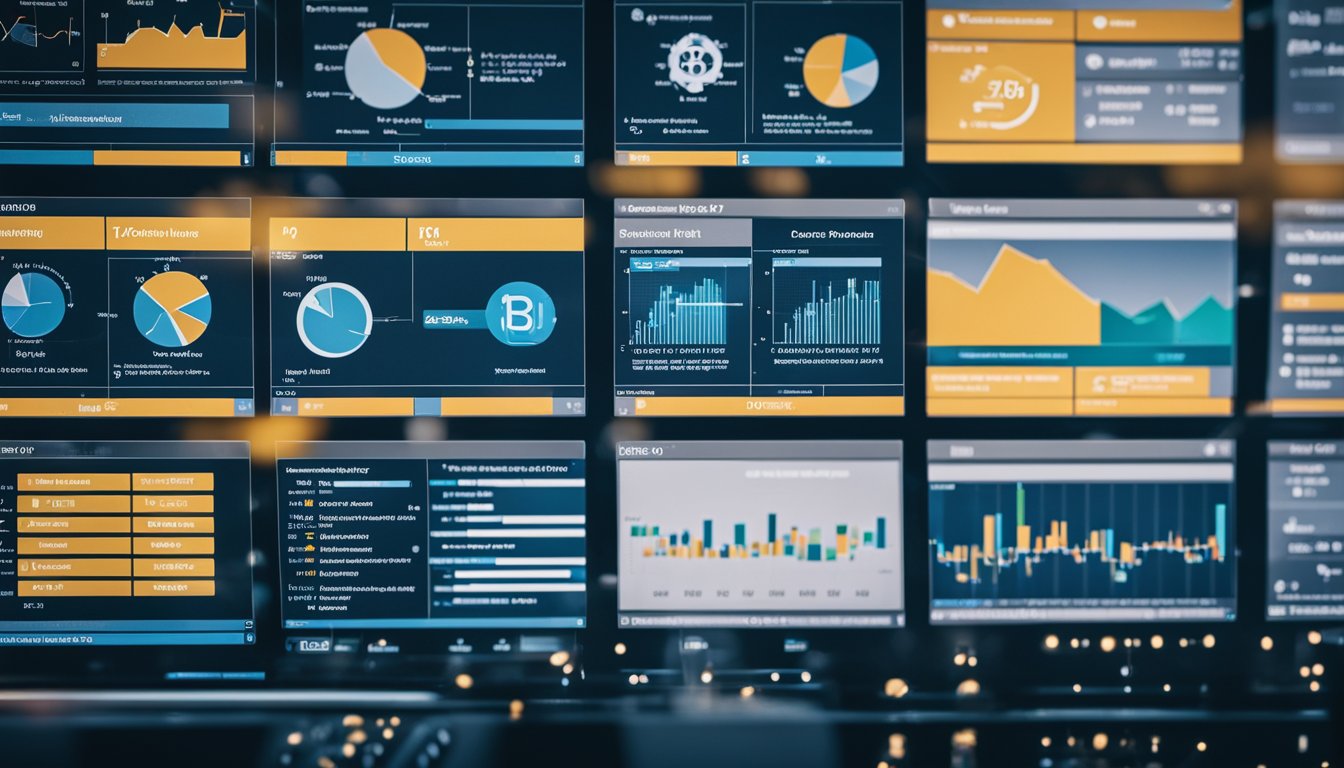Machine Monitoring IoT Solution with Azure Servi and Power BI A Comprehensive Guide
I recently came across an interesting topic, Machine Monitoring IoT Solution with Azure Services and Power BI, which is a great way to monitor and analyze data in real-time. The solution is designed to help businesses and organizations monitor their machines and equipment to ensure they are running smoothly and efficiently. With the help of Azure Services and Power BI, businesses can collect, analyze, and visualize data from their machines in real-time, making it easier to identify potential issues and take corrective action before they become major problems.

The solution is perfect for businesses that rely heavily on machines and equipment to operate. With real-time data monitoring and analytics, businesses can reduce downtime, increase productivity, and improve overall efficiency. By implementing this solution, businesses can gain valuable insights into their machines and equipment, such as performance metrics, usage patterns, and maintenance needs.
Key Takeaways
- Azure Services and Power BI can be used to monitor and analyze machine data in real-time, helping businesses identify potential issues and take corrective action before they become major problems.
- Real-time data monitoring and analytics can help businesses reduce downtime, increase productivity, and improve overall efficiency.
- By implementing the Machine Monitoring IoT Solution with Azure Services and Power BI, businesses can gain valuable insights into their machines and equipment, such as performance metrics, usage patterns, and maintenance needs.
Understanding Azure IoT and Power BI

As an IoT solution architect, I have found that Microsoft Azure IoT and Power BI are two powerful tools that can be combined to provide a comprehensive machine monitoring solution. Azure IoT is a collection of managed and platform services that connect and control IoT devices, while Power BI is a data visualization tool that can be used to perform self-service and enterprise business intelligence.
Azure IoT provides a range of services, including IoT Hub, IoT Edge, and IoT Central. IoT Hub is a cloud-based service that can be used to connect, monitor, and manage IoT devices securely. IoT Edge is a service that allows for the deployment of cloud intelligence to IoT devices. IoT Central is a fully managed SaaS solution that simplifies the creation of IoT solutions.
Power BI, on the other hand, is a collection of software services, apps, and connectors that work together to turn your unrelated sources of data into coherent, visually immersive, and interactive insights. With Power BI, you can create interactive reports, dashboards, and visualizations that can be shared with others.
When combined, Azure IoT and Power BI can provide a comprehensive machine monitoring solution. Azure IoT Hub can be used to collect data from IoT devices, while Azure Stream Analytics can be used to analyze the data and route it to a dataset in Power BI. With Power BI, you can create interactive dashboards that display real-time sensor data, allowing you to monitor and analyze machine performance.
To use Azure IoT and Power BI, you will need an Azure subscription. Once you have an Azure subscription, you can create an IoT Hub and connect your IoT devices to it. You can then use Azure Stream Analytics to analyze the data and route it to a dataset in Power BI.
In summary, Azure IoT and Power BI are two powerful tools that can be combined to provide a comprehensive machine monitoring solution. With Azure IoT, you can connect and manage IoT devices, while with Power BI, you can create interactive dashboards that display real-time sensor data. By combining these two tools, you can monitor and analyze machine performance, enabling you to make data-driven decisions that can improve efficiency and reduce downtime.
Real-Time Data Monitoring and Analytics

As we collect data from sensors, it is crucial to have a way to monitor it in real-time. With Azure Stream Analytics, we can analyze streaming datasets and gain insights into our data. By using Stream Analytics, we can easily monitor temperature, humidity, and other sensor data in real-time.
One of the benefits of using Azure Stream Analytics is that it integrates seamlessly with Power BI. We can use Power BI to visualize and analyze our data in real-time. With a Power BI dashboard, we can create custom visualizations that help us quickly understand our data. We can also use Power BI to create alerts and notifications based on our data, so we can respond quickly to any issues.
To get started with real-time data monitoring and analytics, we first need to set up an Azure Stream Analytics job to consume the data from IoT Hub and route it to a dataset in Power BI. Once we have our data flowing into Power BI, we can start to analyze it and gain insights into our data.
One of the key benefits of real-time analytics is that we can quickly respond to any issues that arise. For example, if we notice that the temperature in a particular area is rising rapidly, we can take action to prevent any damage. By monitoring our data in real-time, we can ensure that we are always aware of any issues that arise and can respond quickly to them.
Overall, real-time data monitoring and analytics is a critical component of any IoT solution. By using Azure Stream Analytics and Power BI, we can gain insights into our data and quickly respond to any issues that arise.
Implementing Machine Monitoring Solution with Azure and Power BI

As I delve into implementing a machine monitoring solution with Azure and Power BI, I first ensure that I have the necessary Azure components such as an IoT hub, event hubs, stream analytics job, and Azure storage account. These components allow me to ingest and process telemetry data from my machines, and store the data for further analysis.
I begin by setting up my endpoint, which is the IoT hub that receives the telemetry data from my machines. I configure my IoT hub to route the data to an event hub, which acts as a buffer for the incoming data. From there, I set up a stream analytics job that processes the data and routes it to a storage account, such as Azure Data Explorer or SQL.
To visualize the data, I use Power BI, a data visualization tool that allows me to create interactive dashboards and reports. With Power BI, I can create line charts and other visualizations that display the telemetry data in real-time. I can also set up filters and other actions to interact with the data.
For anomaly detection, I can use Azure functions or logic apps to trigger alerts when the telemetry data exceeds certain thresholds. I can also use machine learning algorithms to forecast future trends and identify potential issues before they occur.
To further explore the data, I can use scalable data exploration services such as Azure Data Lake or Databricks. These services allow me to perform time series analysis and other advanced analytics on the telemetry data.
Finally, I can use Power BI embedded to embed my dashboards and reports into a web UI or mobile app. I can also use REST APIs to export the data to other systems or create custom reporting solutions.
Overall, implementing a machine monitoring solution with Azure and Power BI provides a powerful and scalable solution for industrial IoT applications. With the right components and tools, I can easily ingest, process, and visualize telemetry data from my machines, and gain valuable insights into their performance and health.
Frequently Asked Questions

How can I send telemetry data to Azure IoT Hub?
To send telemetry data to Azure IoT Hub, you can use any device or platform that supports the MQTT, AMQP, or HTTP protocols. You can also use Azure IoT SDKs to develop custom applications to send data to IoT Hub. Additionally, you can use Azure IoT Central to create and manage your IoT devices and send telemetry data to IoT Hub.
What is the best service to analyze data from IoT Hub?
Azure Stream Analytics is a fully managed, real-time analytics service designed to help you analyze and process fast-moving streams of data from IoT Hub. You can use Stream Analytics to get insights, build reports, or trigger alerts and actions based on the incoming data. Power BI is also a great tool for data visualization and can be used to create real-time dashboards and reports based on data from IoT Hub.
What is Azure IoT Hub and how does it work?
Azure IoT Hub is a fully managed service that enables secure and reliable communication between IoT devices and the cloud. It provides a bi-directional communication channel between devices and the cloud, allowing you to send telemetry data from devices to the cloud and receive commands and notifications from the cloud to devices. IoT Hub also provides device management capabilities, such as device provisioning, configuration, and firmware updates.
What are some examples of Azure IoT Hub in action?
Azure IoT Hub can be used in a variety of scenarios, such as remote monitoring and predictive maintenance of industrial equipment, smart building automation, and asset tracking. For example, a manufacturing company can use IoT Hub to collect data from sensors on their production line and use that data to optimize their operations and reduce downtime.
What is Azure IoT Central and how does it differ from Azure IoT Hub?
Azure IoT Central is a fully managed IoT application platform that simplifies the creation of IoT solutions. It provides a web-based console for creating and managing IoT devices, dashboards, and rules. Unlike IoT Hub, IoT Central is a higher-level service that abstracts away much of the complexity of IoT device management and communication. IoT Central is a great choice for organizations that want to quickly create and deploy IoT solutions without having to worry about the underlying infrastructure.
How much does Azure IoT Hub cost and what are the pricing tiers?
Azure IoT Hub pricing is based on the number of messages sent and received by IoT devices. There are three pricing tiers: Free, Basic, and Standard. The Free tier allows up to 8,000 messages per day, while the Basic and Standard tiers allow up to 400,000 and 6,000,000 messages per day, respectively. The pricing also varies depending on the number of devices connected to IoT Hub and the amount of data stored in IoT Hub. For more information, please refer to the Azure IoT Hub pricing page.

We are committed to delivering a new level of automation that will help organizations save time, money, and staffing resources.
 WRITE FOR US!
WRITE FOR US!
